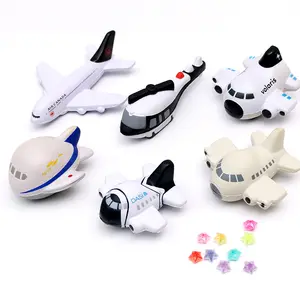
All categories
Featured selections
Trade Assurance
Buyer Central
Help Center
Get the app
Become a supplier

(980 products available)




















































There are various kinds of biplanes toys in the market. Some of them include;
Toy biplanes are more than just playthings. They can stimulate the imagination of children and provide entertainment in many different settings. Here are some of the usage scenarios for these biplanes:
Below are some factors buyers should consider when buying biplane toys for resale:
Age Appropriateness
Toy planes are available for different age groups. For instance, most manufacturers of plane toys for toddlers and younger kids use bright colors and safe materials, including plastic. Additionally, they ensure the planes have no small parts to avoid safety hazards. On the other hand, for older children, the planes have more complex designs and features, such as the ability to fold.
Material and Durability
Most manufacturers make biplane toys using plastic, wood, or metal. Buyers should get their hands on quality plastic and wooden planes. A plastic biplane toy is lightweight, making it ideal for younger children. In addition, it can have intricate designs and movable parts, such as propellers, which are appealing to kids. On the flip side, a wooden toy plane is more durable and can withstand rough handling. It is also easy to paint, and kids can customize it according to their preferences. A metal plane is more durable than plastic and wood and can serve as an excellent collector's item.
Design and Detail
In most cases, a plastic model airplane kit is more detailed than its wooden or metal counterparts. The high level of detail makes it more appealing to kids and collectors. However, buyers should ensure the plane's design is age-appropriate. A plane with a more simple design is easy to assemble and suitable for younger children, while one with a complex design is appropriate for older kids.
Scale and Size
The size of a biplane toy impacts its playability and storage. Thus, buyers should get biplanes in various sizes. They should also be aware that larger planes are often more expensive and require more storage space.
Educational Value
Many toy manufacturers focus on making biplanes that can enhance children's creativity and learning. Therefore, buyers should look for toys that can help children learn about history, aviation, or even basic engineering concepts.
Remote Control Features
Where applicable, buyers should ensure the toy biplanes have user-friendly remote controls. The remote control makes the biplanes more interactive and allows children to engage in more active play.
Some functions and features of biplanes are given below:
Durability
This makes it more suitable for children, who tend to handle toys roughly. A durable plane will withstand drops and rough play without breaking, ensuring longer playtime.
Easy to assemble
Some users may prefer biplanes that are simple to assemble and disassemble. A straightforward process can enhance the user experience and make the toy more appealing to customers.
Realistic details
Many people admire the historic and aesthetic appeal of biplanes. Some may prefer toys that capture this aspect well through quality materials and construction.
Remote control
Some buyers may look for remote control functionality in their toy biplanes. These toys offer an interactive experience that is more appealing to older children and adults.
Safe materials
The safety of the materials used in making the toy is of utmost importance. Non-toxic, safe, and high-quality materials are preferred, especially for toys intended for children.
Flexible pricing
Business buyers are looking for products that can fit within their budget. Therefore, they will look for toy biplanes with a wide range of pricing depending on the quality and features.
Educational value
Some function features buyers will look for in a toy biplane include its ability to teach children about history, engineering, or aviation. Such toys can be more appealing to buyers as they provide more than just entertainment.
The design of a toy biplane will play a significant role in the amount of business it can attract. Buyers are more likely to purchase a biplane with a well-thought-out design that is appealing and eye-catching. Here are some key aspects of design buyers will be interested in:
Aesthetic appeal
The visual appeal of a toy is important. An aesthetically pleasing design can attract more buyers and provide a more enjoyable play experience.
Proportions and dimensions
Buyers will look for proportional and correctly dimensioned biplanes. These are more realistic and can provide a better understanding of how real biplanes appear and function.
Safety
All toys should be safe for children. Therefore, business buyers will look for planes with no sharp edges or small parts that children can swallow.
Age-appropriate designs
Buyers will look for toy planes appropriate for the age of the child. The design will complement the skills and interests of the target age group.
Ergonomic design
Some buyers will look for toys designed to be comfortable to hold and operate. An ergonomic design can enhance the user experience and make the toy more enjoyable to play with.
Q1. What age group is suitable for the toy biplanes?
A1. Depending on their complexity, biplane models are suitable for different age groups. While younger kids enjoy simple, easy-to-use biplanes, older kids and adults can handle detailed and intricate models.
Q2. Can someone paint or customize their biplane model?
A2. Users can customize their biplane models if the manufacturer permits it. This involves using non-toxic paints to personalize the model's appearance. However, users should be careful not to alter the model's aerodynamics or structural integrity.
Q3. What materials are typically used to make biplane toys?
A3. Most biplane toys are made from high-quality wood, metal, or durable plastic. These materials are often used because they can withstand rough play and are safe for kids.
Q4. Are biplane toys educational?
A4. Some biplane models are built to be educational. They include information about aviation history or the mechanics of flight. Moreover, they can help kids understand the principles of flight and develop an interest in aviation.